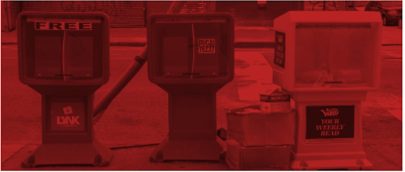The Community News and Small Business Support Act – and the Local Journalism Sustainability Act before it – includes a tax credit for small businesses that buy advertising or sponsorships in local news outlets.
The bill would provide a 50% tax credit for up to $5,000 in advertising expenses. So, a business that spends $10,000 in advertising would, in effect, get up to a $5,000 subsidy (taken from their below-the-line tax payment amount). Versions of this approach have been considered in Colorado, Maryland and Wisconsin.
Politically, this idea has perhaps the broadest appeal of any policy supporting local news outlets, with groups in several conservative states interested in the approach as well as more liberal state legislatures.
The broad appeal comes from the dual benefits of the policy. It primarily benefits small businesses, many of which have been battered by inflation and COVID and have had to decrease their advertising investments. The proposal would help restaurants, car dealerships and grocery stores reach local audiences, helping businesses earn new clients and revenue. Meanwhile, it also provides local news outlets with additional advertising revenue. It is a potent policy two-fer.
Key Elements
The primary beneficiaries of the small businesses advertising tax credit are, as the name suggests, small businesses. Once passed, area news outlets would, to their best awareness, alert area businesses that advertising spending in their publications would be eligible for the tax benefit. The businesses would negotiate the terms with the news outlet, as usual. News outlets would need to give small businesses a receipt or official acknowledgement of the transaction, which the small business would include in its tax filing to receive a rebate of up to 50% of what was spent with the news outlet.
- Advertising decisions are made by the small businesses
The small businesses – not government officials – make the decisions based on their own interests. This serves an important function: It decreases the likelihood that governments will be able to meddle in which outlets ultimately receive advertising revenue. Local media organizations will need to persuade the small businesses to spend their advertising dollars. This eliminates some of the concerns about elected officials manipulating government spending to reward or punish specific news outlets, making the bill a very First-Amendment-friendly approach.
2. This is for small businesses
It is tempting to include large businesses in the proposal. Some large businesses advertise with local news, too, of course. But that would make the plan significantly more expensive and dilute the message that this is about helping small businesses thrive. For the news outlets, the proposal could help establish, or reestablish, their relationship with “Main Street” amid high concentration of digital advertising in larger advertising markets. Additionally, advertising relationships can be self perpetuating. Once established, small businesses may continue advertising in local media even after the policy has sunset, which is good for both the business and for local news.
3. This is for local media
The second purpose of this bill is to help local news. Allowing national media players to benefit would divert tax dollars toward the part of the media economy that needs help the least, and also likely has existing relationships with large advertisers.
4. The amounts should be big enough to move small business spending decisions
There is some work involved for small businesses. They have to pay for the advertising costs up front, get a receipt and file it in their tax returns. If the benefit is tiny, they may not see claiming it as worth the effort. Moreover, if the businesses spend too little on advertising they may not see meaningful growth in consumer interest.
5. The small businesses should have some skin in the game
Requiring businesses to put in some of their own money will encourage businesses to make well considered judgments about what outlets are the best and highest quality venues for their advertising. Meaning, it can act as yet another quality assurance mechanism because small businesses won’t want to put their advertising in outlets that don’t meet their advertising needs.
6. There must be simple, clear criteria about which newsrooms and businesses are eligible
Small businesses should not need to be experts in legislative language to understand how to benefit from the policy. So the criteria for which news organizations are eligible should be clear and understandable, and small businesses should be able to take the word of the local media organization with reasonable confidence. In terms of the policy itself, that means the local media organization should self-attest to qualifying for the scheme and there should be repercussions if a news outlet misrepresents itself.
7. There must be a business tax that can be the vehicle for the subsidy
The federal bill provides a credit against corporate income taxes. If this is a state bill, and the state has no business income tax, it would need to find some other tax to use. Some states have a flat corporate tax or a gross receipts tax instead of a business income tax. In states like Wyoming, where local businesses pay few taxes and no traditional business taxes, a small business grant program could be explored.
Key Issues
How can we reduce the cost of the proposal?
It is hard to know how many small businesses would take advantage of the tax credit, so fiscal agencies may err on the side of assuming many will. That has led some state budget offices to assume that all qualified small businesses will partake (not realistic) and give an inflated price tag on the proposal. There are a few possible ways to deal with this:
- Limit eligibility to certain types of small businesses – Target it explicitly toward the industries most likely to advertise. That might include retail businesses, restaurants, the tourism industry, medical providers and other industries that frequently advertise in local news outlets. Or one could also fashion it as a pilot, focusing on just one of those industries.
- Limit the overall dollar amount in the pool – Stipulate that businesses will get this on a first come, first served basis until a fixed pool of money empties out.
- Limit the size of the small business – You can do this by revenue or employee number. In Wisconsin, for example, lawmakers defined small businesses using both the number of employees and revenue; small businesses qualified if they had fewer than 100 employees and less than $10,000,000 in revenue. Meanwhile, in Colorado, lawmakers defined small businesses as those having fewer than 50 employees.
- Try it first in “distressed communities” – This would certainly reduce the cost and target the taxpayer subsidy to the neediest areas. One risk is that many of the businesses may also be distressed and struggle to front the money necessary to take advantage of the program.
- Make it a grant program – A dedicated small business advertising fund within either a state or local government could achieve the same goals of the small business advertising tax credit while decreasing the ambiguity around the costs of the program. More on that below.
- Limit the size of the benefit – You could lower the dollar value of the benefit. For example, small businesses could get a 30% benefit on up to $10,000 of spending instead of a 50% benefit.
REBUILD LOCAL RECOMMENDATION: We prefer option number one or five, though any of the options one through five could work. We recommend against number six because smaller credits may not move small businesses’ spending behavior. The best approach could be to figure out which businesses are most likely to advertise and either limit the policy to those advertisers or work with the office responsible for calculating the cost of the policy to base their analysis on existing advertising patterns.
Rebuild Local News has worked with business groups and small publishers in several states to make a list of industries most likely to advertise in local news based on North American Industry Classification System codes. Most of the business types are in the following categories: restaurants, grocery stores, retail, real estate, medical and service. States should feel welcome to use the list as an initial guide, but add or omit industries highlighted in our initial list.
How big should the subsidy be?
If the value of the tax subsidy is too low, small businesses may not alter their advertising decisions. Or, if they’re on the fence about advertising with local news, a small amount of money won’t put them over the top.
REBUILD LOCAL RECOMMENDATION: Ideally, the bill would use the federal level – a $5,000 benefit to small businesses – but at a minimum the value of the benefit should be $2,500.
How can we deal with the lag time between purchase decision and when a business gets its tax refund?
Small and low-margin businesses might find a tax credit of this size to be particularly beneficial. But because they run on tight margins they may not be able to front the investment in local advertising if they have to wait between six and 12 months to get the subsidy. This may be a particular problem in historically under-served and low income communities.
REBUILD LOCAL RECOMMENDATION: Foundations, Chambers of Commerce or press associations should set up a cash flow bank to front small businesses the money until they get the tax break. A version of this approach was implemented successfully with American Rescue Plan-funded grants in Meriden, Connecticut, where the city of Meriden allowed small businesses and nonprofits to apply for advertising grants, which were matched with advertising inventory from the Record Journal newspaper. A cash flow bank could be constructed similarly, either as a loan or a grant, with businesses getting a portion of the loan or grant back in their taxes.
Which local newsrooms should be eligible?
Small businesses only get the tax credit if they buy advertising from an eligible local news organization. But what counts as an eligible local news organization?
There are some subjective and political factors. Should it be limited to only those organizations that do local news? Or should, say, the local music radio station be eligible? Or should it be limited to only newspapers?
On the federal level, lawmakers needed to define what counted as a “local” news organization, but states may have an easier time. They can just say it has to be a news organization that primarily serves that state or communities within that state. If they want to have even more objective standards, they could say that the news organization needs to have at least 33% of its audience within the state.
We believe that the credit should be targeted toward those organizations that are providing news, but that does create some definitional issues. The Federal bill says an eligible organization employs at least one full-time local journalist living in the circulation or broadcast area.
REBUILD LOCAL RECOMMENDATION:
We believe that the basic criteria should be:
- The newsroom employs at least one full-time local reporter. That “reporter” can be an owner/operator as long as that owner is contributing to the editorial product of the newsroom.
- The news organization primarily serves that state (possibly defined as having at least 33% of its audience within the state).
- The organization discloses its ownership and is not owned or majority funded by politically-motivated organizations (more on this below).
How small should the small business be?
The federal bill defines small businesses as those with 50 or fewer employees. Other definitions, such as California’s small business definition, have gone up to 100 employees, but have a second tier for “microbusinesses” that employ 25 workers. Ultimately the definition will depend on the business environment in each state.
REBUILD LOCAL RECOMMENDATION: Frankly, this is a matter of balancing cost and politics. The bigger the number, the more businesses will use it, and the bigger the benefit will be to newsrooms. But it will also likely mean a bigger price tag for the state. So it is probably worth limiting the benefit to businesses with 50 employees or fewer in order to make the bill more viable from a state budget perspective. If it works, there could be an opportunity to increase the size of the eligible small businesses.
How do we keep the benefit from going to “pink slime” websites?
The Community News and Small Business Support Act added some safeguards to keep pink slime from benefiting from the bill. Requiring that the small business put in some money also provides an additional barrier to entry, as small businesses will likely be reluctant to buy advertising at politically-backed websites (since they will lose their own money if that advertising is ineffective).
REBUILD LOCAL NEWS RECOMMENDATION: The criteria for what makes a newsroom eligible should include some (or all) of the following:
- The news organization discloses its end-of-line ownership on its website
- The news organization is not owned, controlled or majority funded by a Political Action Committee (meaning organizations designated under Section 527 of the U.S. tax code), or any organization designated under Section 501 of the U.S. tax code except 501(c)3 organizations
How will a small business know if a newsroom is eligible?
No bill has explicitly dealt with this question, but it came up during discussions at the federal level. One idea was to add ‘good faith’ language that would enable a small business to rely on the assurance of a newsroom. If a newsroom says – or certifies – that they’re eligible, the small business should be able to take that as true without having to do investigative work as to whether the newsroom is legitimate. So the legal burdens – and penalties for misrepresenting itself – would fall on the newsroom, not the small business.
REBUILD LOCAL RECOMMENDATION: Add language that ensures the small business should get the credit if they advertise with a publication that has stated on its website that it is an eligible publication. If the publication is wrong, no penalty should be imposed on the small business but rather on the publication that misled the public.
Are nonprofit news organizations eligible?
Yes. The intention of all these proposals is to help nonprofit as well as for profit newsrooms. Local advertising accounts for a portion of many local nonprofits’ sustainability plans and local public radio stations are beginning to develop local advertising strategies. This policy could help reinforce these efforts. When Colorado introduced the policy in 2021, local news outlets were able to write a definition that, according to local public broadcasters, would have included underwriting in public radio. (See appendix)
REBUILD LOCAL NEWS RECOMMENDATION: Consider using the language “advertising, underwriting or sponsorships.” Or, you could, in the definitions section of the law, define advertising as including sponsorships or underwriting offered to eligible nonprofit local newsrooms.
Are nonprofit advertisers eligible?
No. At least we haven’t seen any tax plan that would include nonprofits since nonprofits do not pay corporate income taxes. The grant programs are better able to address this issue. See below.
Are TV and radio eligible?
Yes. Most of the bills include all forms of media. On one hand, local businesses should be able to pick the news outlets they feel would be most effective for them; and politically, including broadcasters broadens the tent of advocating news media to include broadcasters, both commercial and public. On the other hand, including broadcasters might eat into the potential advertising dollars of newspapers or digital-only publications.
REBUILD LOCAL NEWS RECOMMENDATION: Yes, television and radio should be included. The political and practical benefits outweigh the arguable benefits of focusing the policy on newspaper advertising.
How should we make the argument to lawmakers?
This policy would support the local news business model, but, firstly, it’s a benefit to small businesses. Stating the small business benefit as often as you can, as plainly as you can (hopefully in coordination with local business groups), could increase the policy’s political chances. You should also make clear that advertising drives local economies. In many states, particularly ones that rely heavily on state or local sales taxes to fund budgets, that means higher tax revenue. And, of course, you should reinforce with lawmakers that by supporting the business model for local journalism, they can protect local news institutions, which make democracies and communities healthier.
Next: Model Law




